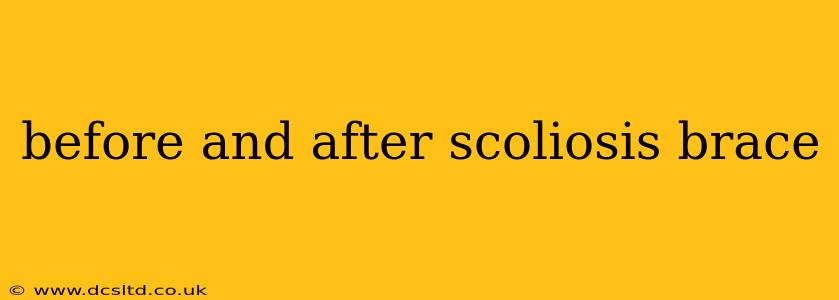Scoliosis, a sideways curvature of the spine, can significantly impact a person's posture, health, and self-esteem. For many individuals, bracing is a crucial part of treatment, aiming to slow or prevent the progression of the curvature. Seeing "before and after scoliosis brace" images can be incredibly powerful, offering a visual representation of the potential benefits. However, it's essential to understand the nuances of bracing, the realistic expectations, and the individual factors influencing outcomes. This comprehensive guide explores the before-and-after experience, addressing common questions and misconceptions.
What Does a Scoliosis Brace Do?
A scoliosis brace doesn't "cure" scoliosis; rather, it works by applying pressure to the spine, gently guiding it towards a straighter alignment. The type of brace prescribed depends on several factors, including the severity and location of the curve, the patient's age and skeletal maturity, and the overall health of the individual. Common types include Boston braces, Milwaukee braces, and Charleston bending braces. The brace is designed to be worn for a significant portion of the day, often 16-23 hours, depending on the doctor's recommendations.
What Can I Expect Before Starting Brace Treatment?
Before initiating brace treatment, a comprehensive evaluation is necessary. This typically involves:
- Physical Examination: A thorough assessment of the spine's curvature, posture, and overall musculoskeletal health.
- Imaging Studies: X-rays are essential to measure the degree of curvature (Cobb angle) and determine the appropriate treatment plan.
- Brace Fitting: A custom-fitted brace is crucial for optimal effectiveness and comfort. This process might involve multiple appointments.
- Instructions and Education: The healthcare team will provide detailed instructions on how to wear, care for, and adjust the brace.
What Are Realistic Expectations for Before and After Results?
The "before and after" results are highly individual and depend on multiple factors. These include:
- Severity of the Curvature: Smaller curves are generally easier to manage with bracing.
- Skeletal Maturity: Bracing is most effective in children and adolescents whose bones are still growing.
- Adherence to the Treatment Plan: Consistent brace wear is crucial for achieving the best possible outcomes.
- Type of Brace: Different brace designs offer varying levels of correction.
- Age at Treatment Initiation: Early intervention usually leads to better results.
While a brace might not completely straighten the spine, it often significantly reduces the curve's progression, preventing further deformity and potential future complications. Many individuals experience improved posture and a reduction in back pain.
How Long Will I Wear a Scoliosis Brace?
The duration of brace wear varies significantly, depending on factors like the individual's age, skeletal maturity, and the curve's response to treatment. It's typically continued until skeletal maturity is reached, which often occurs around the age of 16 for girls and 18 for boys. Regular monitoring with X-rays is essential to track progress and adjust the treatment plan as needed.
What are the Potential Side Effects of Wearing a Scoliosis Brace?
While bracing is generally safe and effective, potential side effects include:
- Skin Irritation: Proper skin care and hygiene are vital to prevent skin problems under the brace.
- Discomfort: Initially, the brace might cause some discomfort, but this usually subsides as the body adjusts.
- Social Impact: Wearing a brace can be challenging socially for some individuals. Open communication with family, friends, and school staff can help address this.
- Difficulty with Activities: Certain activities might be challenging while wearing the brace.
Can I See Before and After Photos of Scoliosis Brace Treatment?
While sharing individual patient photos is not ethically appropriate due to privacy concerns, many reputable medical websites and journals publish scientific studies with imaging data showing the effectiveness of scoliosis bracing. It's crucial to seek out such sources for accurate and relevant information, rather than relying on anecdotal evidence.
What Happens After I Stop Wearing My Scoliosis Brace?
After the brace is removed, regular follow-up appointments are essential to monitor the spine's alignment and prevent recurrence. Physical therapy might be recommended to improve posture, strength, and flexibility. The goal is to maintain the progress achieved during bracing and to encourage healthy spinal habits for long-term well-being.
This information is for general knowledge and does not constitute medical advice. Always consult with an orthopedic specialist or scoliosis specialist for personalized diagnosis and treatment planning. They can provide accurate information about your specific situation and answer your questions thoroughly. Remember, the before-and-after experience is unique to each individual, and realistic expectations are key to successful treatment and a positive outcome.
